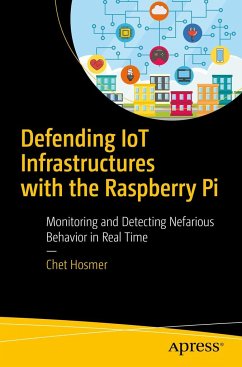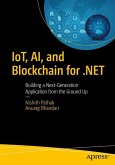Apply a methodology and practical solutions for monitoring the behavior of the Internet of Things (IoT), industrial control systems (ICS), and other critical network devices with the inexpensive Raspberry Pi. With this book, you will master passive monitoring and detection of aberrant behavior, and learn how to generate early indications and warning of attacks targeting IoT, ICS, and other critical network resources.
Defending IoT Infrastructures with the Raspberry Pi provides techniques and scripts for the discovery of dangerous data leakage events emanating from IoT devices. Using Raspbian Linux and specialized Python scripts, the book walks through the steps necessary to monitor, detect, and respond to attacks targeting IoT devices.
There are several books that cover IoT, IoT security, Raspberry Pi, and Python separately, but this book is the first of its kind to put them all together. It takes a practical approach, providing an entry point andlevel playing field for a wide range of individuals, small companies, researchers, academics, students, and hobbyists to participate.
What You'll Learn
Create a secure, operational Raspberry Pi IoT sensor
Configure and train the sensor using "normal" IoT behavior
Establish analytics for detecting aberrant activities
Generate real-time alerts to preempt attacks
Identify and report data-leakage events originating from IoT devicesDevelop custom Python applications for cybersecurity
Who This Book Is For
Cybersecurity specialists, professors teaching in undergraduate and graduate programs in cybersecurity, students in cybersecurity and computer science programs, software developers and engineers developing new cybersecurity defenses, incident response teams, software developers and engineers in general, and hobbyists wanting to expand the application of Raspberry Pi into both IoT andcybersecurity
Defending IoT Infrastructures with the Raspberry Pi provides techniques and scripts for the discovery of dangerous data leakage events emanating from IoT devices. Using Raspbian Linux and specialized Python scripts, the book walks through the steps necessary to monitor, detect, and respond to attacks targeting IoT devices.
There are several books that cover IoT, IoT security, Raspberry Pi, and Python separately, but this book is the first of its kind to put them all together. It takes a practical approach, providing an entry point andlevel playing field for a wide range of individuals, small companies, researchers, academics, students, and hobbyists to participate.
What You'll Learn
Create a secure, operational Raspberry Pi IoT sensor
Configure and train the sensor using "normal" IoT behavior
Establish analytics for detecting aberrant activities
Generate real-time alerts to preempt attacks
Identify and report data-leakage events originating from IoT devicesDevelop custom Python applications for cybersecurity
Who This Book Is For
Cybersecurity specialists, professors teaching in undergraduate and graduate programs in cybersecurity, students in cybersecurity and computer science programs, software developers and engineers developing new cybersecurity defenses, incident response teams, software developers and engineers in general, and hobbyists wanting to expand the application of Raspberry Pi into both IoT andcybersecurity








